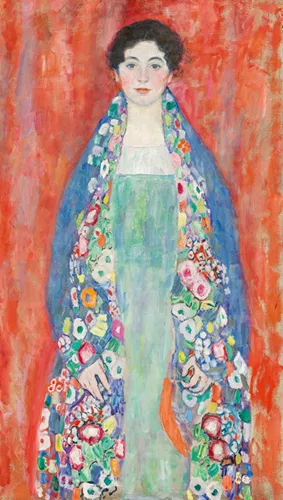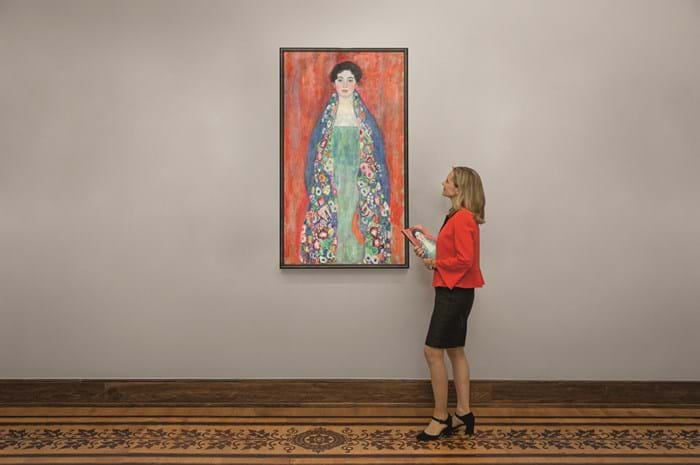
Portrait of Fräulein Liese, estimated at €30m-50m at im Kinsky.
Image copyright: Auktionshaus im Kinsky GmbH, Wien
Although known from preliminary studies and a photograph related to a 1926 exhibition, its whereabouts had been previously unknown for almost a century.
Titled Portrait of Fräulein Lieser, the three-quarter-length portrait of a young woman has been dated to 1917, making it one of Klimt’s last works. A typically large work in an elongated format, the 4ft 7in x 2ft 7in (1.4m x 80cm) oil on canvas is dazzlingly coloured but certain parts were seemingly left unfinished at the time of his death.
It shows the subject depicted in a frontal pose close to the foreground and set against a red, undefined background. A cape richly decorated with flowers is draped around her shoulders.
The sitter has been identified as Margarethe Constance Lieser (1899-1965), the daughter of the industrial magnate Adolf Lieser. It is believed to have been part of the Liesers’ collection at around the time of the 1926 exhibition (although it is not known whether it was actually exhibited there) but its exact fate since then is unclear.

The Gustav Klimt portrait being offered at im Kinsky was believed to be lost but has come to auction following an agreement between the Austrian owners and the family who commissioned the picture.
Image copyright: Auktionshaus im Kinsky GmbH, Wien
The Liesers were among the families persecuted under the Nazis’ anti-Jewish laws with much of their assets seized including furniture, musical instruments and paintings. Most of the family fled Austria between 1938 and 1945 and at least one member was murdered by the Nazis.
According to im Kinsky, ‘no evidence’ exists that this particular work was ‘stolen or otherwise unlawfully seized, either before or during the Second World War’. The auction house therefore believes it is possible the current picture left the Liesers’ collection before the Nazis came to power in Austria.
At some point however it was acquired by an unnamed art dealer in Vienna from whom it was acquired by a member of the current owner’s family. According to the saleroom, it has been ‘Austrian private property since the 1960s’ and has passed down to the current owner through three successive inheritances.
Washington Principles
The auction house stated that the painting will be “auctioned on behalf of the current owners and the legal successors of Adolf and Henriette Lieser, based on an agreement in accordance with the Washington Principles”.
The Washington Principles, which were endorsed by 44 countries in 1998 including Austria, the US and UK, created new standards for locating and recovering Nazi-confiscated art.
Following the ownership agreement, Austria’s Federal Monuments Office has now issued a permit to export the painting, something crucial in terms of the commercial potential of Portrait of Fräulein Lieser.
Another late portrait by Klimt titled Dame mit Fächer (Lady with a Fan) sold at Sotheby’s in London for £74m in June last year, a record for any artwork ever sold at an auction in Europe.
Klimt's patrons
Members of the Lieser family belonged to a circle of wealthy Viennese collectors which provided Klimt with most of his patrons and clients. The brothers Adolf and Justus Lieser were among the leading industrialists of the Austro-Hungarian monarchy, while Henriette Amalie Lieser-Landau, known as Lilly and who was married to Justus Lieser until 1905, was a noted patron of avant-garde artists.
Catalogues of Klimt's paintings indicate that Adolf Lieser commissioned Klimt in 1917 to paint a portrait of his 18-year-old daughter Margarethe Constance, the leading candidate for the sitter of the current portrait. In April and May 1917, she visited Klimt's studio in Hietzing nine times to pose for him.

The portrait at im Kinsky is a late work by Gustav Klimt, believed to date from the year before the artist’s death.
Image copyright: Auktionshaus im Kinsky GmbH, Wien
However, there is also some suggestion that the art-loving Lilly also commissioned Klimt to paint one of her two daughters too, Helene and Annie.
While Margarethe Constance Lieser emigrated from Austria to Hungary and later fled to Britain, Henriette Lieser remained in Vienna after the Nazis came to power in Austria. She is thought to have been deported in 1942 and either murdered in Riga or transported to Auschwitz.
Even though the sitter’s identity of the current picture is not entirely certain, the portrait is documented and was known to experts from the black-and-white photograph for the 1926 exhibition. At least 25 preliminary studies were also made with examples now in the Leopold Museum in Vienna, the Wien Museum, the Lentos Art Museum in Linz and the Serge Sabarsky Collection in New York.
The saleroom said: “Now, for the first time, the bright colours of the portrait can be seen. The painting is characterised by the vivid intensity that distinguishes Klimt's palette in his late creative years.”
It added: “While Klimt depicts the face of Fräulein Lieser with precise strokes in a sensitive, naturalistic manner, other parts of the picture reflect the free, open brushwork of his late style. Strong complementary tones define the colour palette. The intense colors of the painting and the shift towards loose, open brushstrokes show Klimt at the height of his late period.”
Klimt restitutions
- In 2006, an Austrian arbitration panel ruled that five oils by Klimt in Vienna's Gallery Belvedere should be restored to the heirs of the artist’s model Adele Bloch-Bauer. These included the famous Portrait of Adele Bloch-Bauer I which was subsequently bought by cosmetics magnate Ronald S. Lauder for a landmark $135m (a record for any work of art at the time) in a deal brokered privately by Christie’s. The Bloch-Bauer pictures had been left behind when Adele’s widowed husband fled Austria to Prague after the Nazi's annexation of the country in 1938.
- In 2011, Sotheby’s sold Litzlberg am Attersee, a landscape by Klimt, for $36m (£23.7m) in New York. It had been restituted to the descendants of Austrian iron magnate Viktor Zuckerkandl, from whom it was stolen again after the Nazi annexation of Austria.
- In 2015, Klimt’s portrait of Gertrud Loew made £22m at Sotheby's London. It was consigned following a settlement between the heirs of the painting's subject and the Klimt Foundation. The picture was lost when the Nazis took possession of the family home in Vienna in 1939.
- In 2023 Ronald Lauder himself reached a restitution agreement over Klimt’s The Black Feather Hat, a painting that he had owned for five decades. As part of the deal, Lauder agreed to reacquire the work from the descendants of its original Jewish owner, Irene Beran, to give him legal title. Beren had fled Europe to avoid Nazi persecution, landing in New York in 1947.





